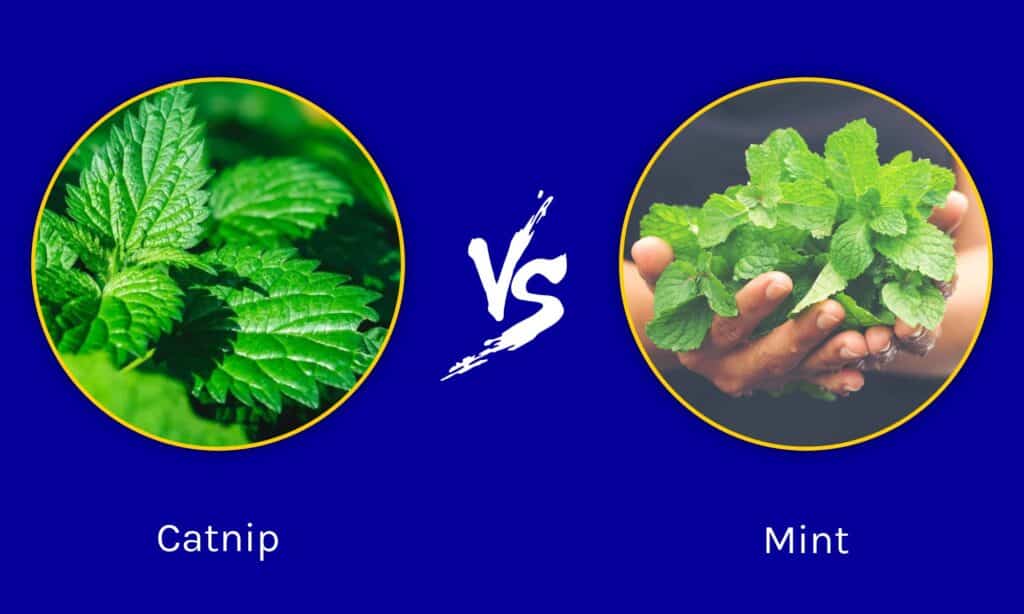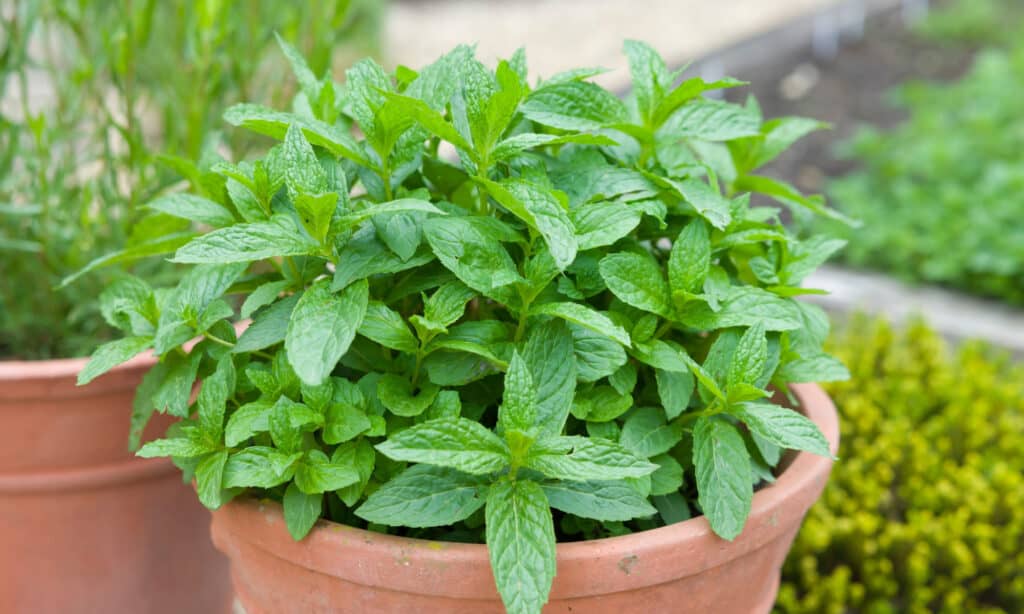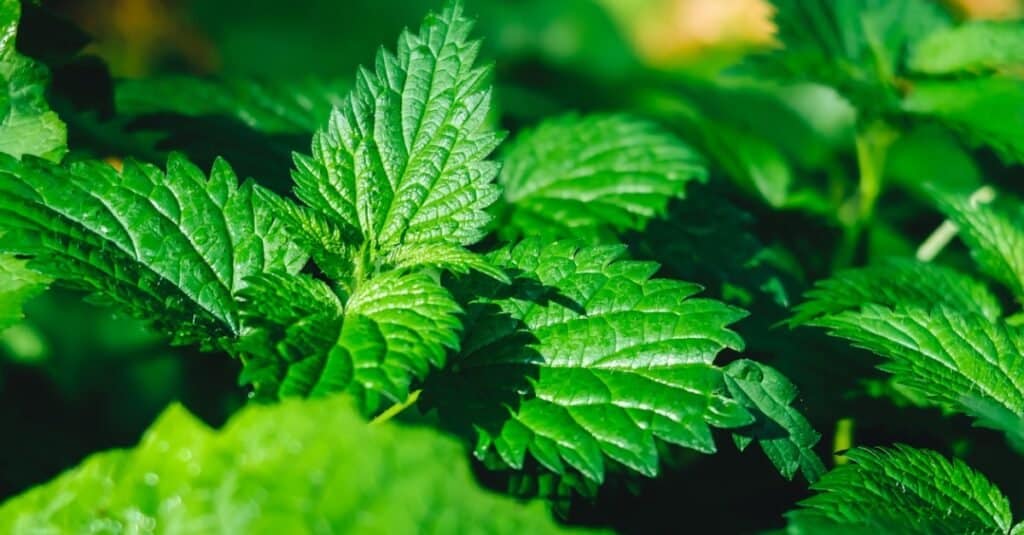Catnip and mint are herbs from the Lamiaceae (mint) family. Both herbs have strong aromatic scents that are attractive to humans, bees, and other insects, but catnip has a scent that is specifically appealing to cats and repulsive to deer. We’ve all asked this question, why do cats like catnip? What’s the science behind this phenomenon? We must first understand what makes catnip different from other herbs.
Mint is one of the most popular scents on our planet. It is a favorite flavor for toothpaste, ice cream, tea, essential oils, and cleaning products. At first glance, these two might look alike, but several distinct features can help you tell them apart. Let us dive into specific details and tackle the difference between catnip and mint.
Comparing Catnip vs. Mint

| Catnip | Mint | |
|---|---|---|
| Classification | Kingdom: Plantae Clade: Tracheophytes Clade: Angiosperms Clade: Eudicots Clade: Asterids Order: Lamiales Family: Lamiaceae Genus: Nepeta Species: Nepeta cataria | Kingdom: Plantae Clade: Tracheophytes Clade: Angiosperms Clade: Eudicots Clade: Asterids Order: Lamiales Family: Lamiaceae Subfamily: Nepetoideae Genus: Mentha |
| Plant Type | Edible, herbaceous, perennial | Edible, herbaceous, perennial |
| Effect on Cats and Insects | Hallucinogenic properties on cats; insect repellent | Insect repellent; may be used against rodents too |
| Human Uses | – Sedative effects on humans; – Used for medicinal purposes, especially in the form of essential oil; – Catnip leaves are used for culinary purposes; – Flowers are used for detergents and deodorant | – Primarily used in essential oil; – Has antifungal, antimicrobial, and anti-inflammatory properties; – Menthol is used in toothpaste, pain balms, and cold balms; – Popular for culinary uses |
The Key Differences Between Catnip vs. Mint
Aside from the difference in classification, catnip and mint also have different effects on humans and animals. Let’s discuss three key dissimilarities between the two.
Catnip vs. Mint: Classification

Mint is well known for its medicinal value and aromatic properties.
©Paul Maguire/Shutterstock.com
Catnip, scientifically called Nepeta cataria, is a perennial herb from the catmint genus (Nepeta) in the Lamiaceae family. Among the hundreds of multiregional Nepeta species are Greek catmint (Nepeta parnassica), Camphor catmint (Nepeta camphorata), Lemon catmint (Nepeta citriodora), Raceme catnip (Nepeta racemosa), and many more.
The term “mint” applies to all the species that belong to the Mentha genus in the Lamiaceae family. Mint is well known for its medicinal value and aromatic properties. There are over 20 species of Mentha worldwide. Nowadays, it can be commercially produced or cultivated in home gardens. There are many types of mint. Here are some of its recognized species:
| Mentha Species | Common Name |
|---|---|
| Mentha alaica | – |
| Mentha aquatica | Watermint, marsh mint |
| Mentha arvensis | Wild mint, field mint, Japanese peppermint, corn mint, banana mint |
| Mentha atrolilacina | Slender mint |
| Mentha australis | Australian mint |
| Mentha canadensis | Canada mint, American wild mint |
| Mentha cervina | Hart’s pennyroyal |
| Mentha cunninghamii | New Zealand mint, Maori Mint |
| Mentha dahurica | Dahurian thyme |
| Mentha darvasica | – |
| Mentha diemenica | Slender mint |
| Mentha gattefossei | – |
| Mentha grandiflora | – |
| Mentha japonica | – |
| Mentha laxiflora | Forest mint |
| Mentha longifolia | Horse mint |
| Mentha micrantha | – |
| Mentha pamiroalaica | – |
| Mentha piperita (popular hybrid mint species) | Peppermint – Eau de Cologne Mint (Mentha x piperita ‘Citrata’) – Lavender Mint (Mentha piperita x ‘Lavender Mint’) |
| Mentha pulegium | Pennyroyal |
| Mentha requienii | Corsican mint |
| Mentha royleana | – |
| Mentha satureioides | Native pennyroyal |
| Mentha spicata | Spearmint, garden mint (a cultivar of spearmint) |
| Mentha suaveolens | Apple mint, pineapple mint (a variegated cultivar of apple mint) |
Catnip vs. Mint: Effect on Cats and Insects

Catnip has hallucinogenic properties that affect 50 to 75 percent of cats.
©Attila Fedyk/Shutterstock.com
According to studies, catnip has hallucinogenic properties that affect 50 to 75 percent of cats. Catnip produces an essential oil called nepetalactone that affects the nervous system. Catnip exerts its influence when it passes through the olfactory bulb, which is responsible for the sense of smell.
Affected cats may show different ranges of euphoric behaviors such as sniffing, licking, chewing the plant, shaking the head, chin and cheek rubbing, rolling, and body rubbing. Aside from cats, bees are also attracted to catnip flowers.
While it’s a cat’s favorite, catnip works as a repellent against mosquitoes and other flies.
Mint’s scent, called menthol, is a natural insect repellent. This scent will deter insect pests such as mosquitoes, ants, cockroaches, flies, and even rodents such as rats.
Catnip vs. Mint: Human Uses
Catnip has sedative effects on humans and can induce sleep. It’s consumed as tea and can greatly help if you have insomnia. On top of that, it is also essential in traditional medicine because it relieves stomach pains.
Essential catnip oil is rich in carvacrol and thymol, which have antiseptic characteristics for treating cough and cold. It is great for treating irritated skin and can remove sebum that causes unwanted acne. Catnip leaves can be used for herbal teas, soups, stews, pasta, and sauces. Catnip flowers are used to make detergents and deodorants.
Mint is primarily used in essential oils. It is one of the oldest medicinal herbs, and its importance can be traced back to Ancient Greek, Roman, and Egyptian cultures. Today, its value is backed up by science. Studies have shown that mint essential oils have antifungal and antimicrobial properties.
This herb is one of the most famous worldwide, especially for culinary purposes. It can be used in herbal teas, beverages, sauces, jellies, and vinegar. Fresh leaves are also added to salads, meat dishes, and pasta.
Peppermint is well known for its fresh, sharp smell. It is one of the strongest and spiciest species of mint. Peppermint oil treats headaches and colds. It is widely used in various industries, such as food, pharmaceuticals, perfumery, and flavoring.
Menthol, mint oil’s main constituent, is also used to manufacture lozenges, toothpaste, pain balms, and cold balms. It is also used in cough drops and as a main ointment ingredient. On top of this, menthol is a natural pesticide, and insects will stay away from this scent as much as possible.
Up Next:
The photo featured at the top of this post is © Attila Fedyk/Shutterstock.com
Sources
- Science Direct, Available here: https://doi.org/10.1016/B978-0-12-803642-6.00011-3
- Science Direct, Available here: https://www.sciencedirect.com/topics/agricultural-and-biological-sciences/mentha
- Plants of the World Online, Available here: https://powo.science.kew.org/taxon/urn:lsid:ipni.org:names:30016176-2
- Nepeta Cataria, Available here: https://nepetacataria.org/nepeta-cataria-effects-on-humans/
Thank you for reading! Have some feedback for us? Contact the AZ Animals editorial team.






